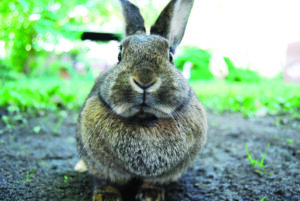By Dr. Beth Leermakers
Have you ever wondered why the Easter Bunny — not the Easter Chicken — delivers eggs to children? According to neopagan legend, one winter a little girl found a wounded bird and called upon Eostre — the goddess of the moon, fertility and spring — for help. Eostre (aka Ostara) appeared over a rainbow bridge, wearing a red robe of sunlight that melted the snow and ushered in spring. Oestre couldn’t heal the injured bird, so she transformed it into a snow hare who brought rainbow eggs. Oestre told the little girl to watch for the arrival of the snow hare in the woods, signaling the beginning of spring.

Photo courtesy of WikiMedia Commons
According to the British historian Bede, the word “Easter” comes from Eostre, whose name was given to an entire month (“Eostur-month”) and then to one specific holiday (that we call Easter) occurring in that month. Eostre, who shape-shifted into a hare at each full moon, was often pictured with a hare’s head or ears, and with a white hare standing by her side. This magical white hare laid brightly colored eggs that were given to children during spring fertility festivals. Today’s Easter Bunny descends from this magical hare.
Rabbits and hares (larger than rabbits, with longer ears and legs) have appeared in folklore worldwide.
Moon Rabbit
In western folklore, we refer to the “man in the moon,” but for many cultures “the hare (or rabbit) in the moon” is a more familiar image. In China, the Hare in the Moon is pictured with a mortar and pestle in which he mixes the elixir of immortality. The hare is the messenger of a female moon deity and the guardian of all wild animals. In Chinese folklore, female hares conceive through the touch of the full moon’s light (without needing a male), or by crossing water by moonlight, or licking moonlight from a male hare’s fur. Representing longevity, fertility, and the feminine power of yin, figures of hares or white rabbits are commonly found at Chinese Moon Festivals. The Moon Rabbit stars in many Chinese folktales, including one where it saved Beijing from the plague.
Fortune Tellers
and Mediums
Rabbits and hares were forbidden foods to the Celtic people. In Ireland, eating a hare was said to be like eating your own grandmother — perhaps due to the sacred connection between hares and goddesses, warrior queens and female fairies, or due to the belief that old wise women could transform into hares by moonlight. The Celts used hares for divination (attempting to foretell the future by supernatural means) by studying the patterns of their tracks and the rituals of their mating dances. The Celts believed rabbits lived underground so they could better communicate with the spirit world. According to legend, rabbits carried messages from the living to the dead and from people to the fairies.
Witches’ Familiars
In the Middle Ages, rabbits and hares were linked to witchcraft, viewed suspiciously as witches’ familiars or witches themselves in animal form. According to Nordic and British legend, witches can transform into hares and, in that form, commit mischievous or evil deeds. In one story, a hunter wounded a hare and followed its blood trail back to a cottage in the woods, where he found an old woman at her stove. She claimed the fresh cut on her arm was due to an accident with a kitchen knife. However, according to folklore, a witch could cast a spell to take on a hare’s shape, speed, power and ability to vanish at will. The circumstantial evidence (her wound) was enough to condemn the woman to death as a witch.
Many folk tales feature men who are led astray by hares (really witches in disguise). In one story, a hunter named Bowerman disturbed a coven of witches while they were practicing their craft. Determined to take revenge upon the man, one woman shape-shifted into a hare, led Bowerman through a deadly bog, and then turned him and his hounds into piles of stones. The stone formations, known as Hound Tor and Bowerman’s Nose, still exist today in Dartmoor, England.
Truth: Rabbits Usually Don’t Make Good Pets
for Children
You may be tempted to adopt a rabbit for your child, especially this time of year. However, as cute as rabbits are, they usually aren’t a good choice to be a child’s pet. Rabbits are prey animals, and people are considered predators, so rabbits don’t like to be picked up and cuddled. They prefer to be in control, with their feet on the ground. You would be better off adopting a small animal that enjoys being held.
Celebrate Easter
While Supporting
Spay Neuter Network
Instead, take your dog to Norbuck Park on Saturday, April 9 for Spay Neuter Network’s Easter Bone Hunt. Your pooch can search for treats and toys, play games (bobbing for tennis balls, anyone?), and pose for photos with the Easter Bunny while you enjoy treats from food trucks. Visit spayneuternetwork-bloom.kindful.com/e/easter-bone-hunt to purchase tickets. All proceeds help Spay Neuter Network provide low cost vaccinations and spay/neuter surgeries for North Texas pets. Happy Easter!
